Want to Buy the Best Material For Pots and Pans?
Choosing the right cookware material can be difficult if you aren’t an expert.
Currently, there is a problem of oversupply in the cookware industry. It’s impossible to narrow it down to just a few favorites among the thousands of options.
In this post, we’ll look at various types of cookware material and see how they differ in terms of features.
Best Cookware Material
Stainless Steel
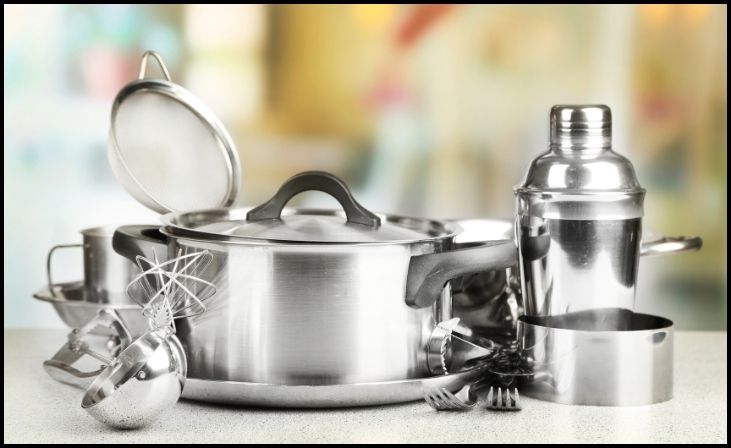
One of the most often used cooking surfaces is stainless steel, which is the only option in many countries. Even though stainless steel is a poor conductor of heat, its properties make it a far superior material for various uses.
Stainless steel cookware is usually made of two different metals with a core of aluminum or copper. The ones with a copper core are unquestionably more expensive, but they are superior in terms of efficiency and durability.
Stainless steel cookware is also extremely simple to clean, as it can be simply washed with soap and water.
Cookware made of stainless steel is one of the most adaptable on the market since you can use it on all cooktops, including ovens, stoves, and broilers. They are also versatile.
You can use them for searing, sautéing, braising, creating sauces, serving as a stock pot, and so on.
Pros
- nonreactive
- heats up quickly
- dishwasher safe
- oven safe
Cons
- tougher to clean
- doesn’t distribute heat well
Aluminum
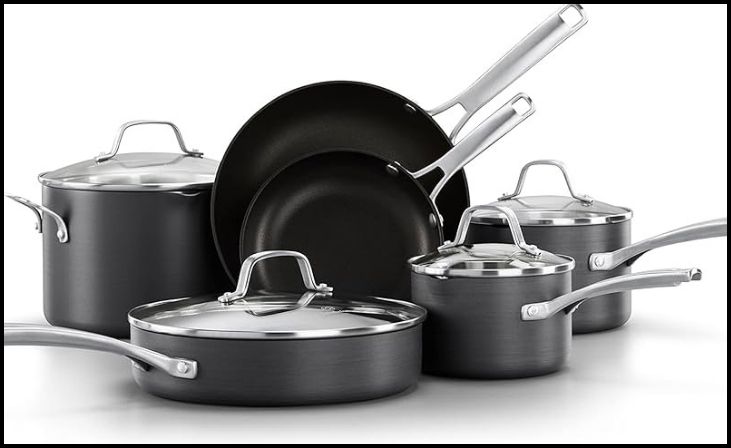
The availability of aluminum and its cost makes it one of the most widely used materials in the world. In order to make aluminum cookware, it must first be treated to make it less brittle and reactive.
Aluminum cookware is frequently made through anodizing, a process that hardens and protects the metal against corrosion.
Almost all commercial bakeries employ aluminum steel trays because of their great attributes of longevity, resistance to corrosion, and exceptionally effective heat transfer. In addition, cleaning and maintaining aluminum is a breeze.
In most cases, anodized aluminum is dishwasher safe as well. However, aluminum cookware is best suited for searing, sautéing, and baking.
Due to its low cost and ease of processing, aluminum is the most versatile of all metals when it comes to design options, colors, and finishes, including nonstick.
Pros
- lightweight
- retains heat well
- durable and scratch-resistant
Cons
- reacts with certain food
- expensive
Copper

Copper is one of the world’s oldest and most widely used metals. As a result, it hasn’t become a household name in the kitchen due to its high cost.
Copper conducts heat well and reacts rapidly to temperature changes. Although copper cookware can be used for a wide range of cooking methods, it is not suitable for induction cooktops due to its conductivity.
In addition, copper requires a little more care than stainless steel.
Pros
- great heat retention properties
Cons
- reactive
- expensive
Cast Iron

When it comes to cooking, cast iron is one of the most adaptable materials. It can be used on practically any cooking surface. However, cast iron cookware has the drawback of being rather difficult to clean and care for.
For best results, season the cast iron cookware regularly to keep it from sticking; after that, you’ll have a long-lasting and cheap cooking surface that holds heat for a longer period.
However, Cast iron cookware is heavier and reactive if not properly seasoned.
Pros
- affordable and durable
- versatile
- retain heat well
- go from the stovetop to the oven
Cons
- not ideal for cooking acidic food
- need maintenance
- cleaning needs extra effort
Nonstick
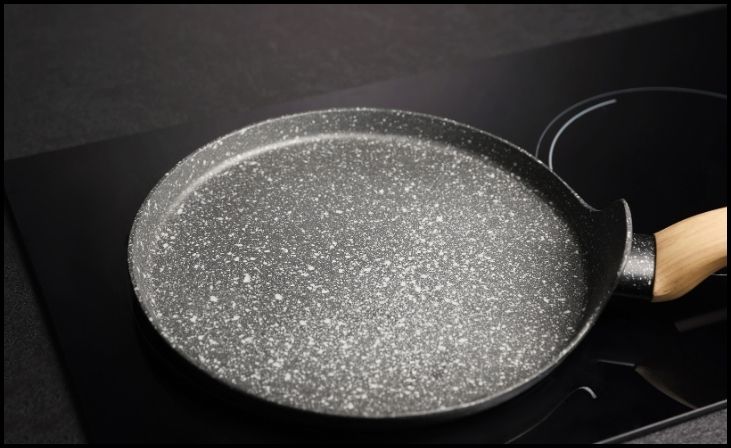
Nonstick cookware is gaining popularity worldwide due to its simplicity, adaptability, enormous choice, and ability to cook with less fat and be easy to clean and maintain. These metals and others can be used to make nonstick pans, which are then covered with a special nonstick coating.
Aluminum is the most frequently utilized metal in the production of nonstick cookware due to its good features as a lightweight, corrosion-resistant, excellent heat conductor, and reasonably priced.
When it comes to cooking, nonstick pans can be used for any type of food, but they’re most commonly employed for food that tends to adhere to a pan’s surface. Abrasive cleaning products and brushes should not be used on nonstick cookware since they can damage the surface.
Pros
- easy to clean
- smooth coating
- requires less oil
Cons
- expensive
- don’t use too high heat
Carbon Steel
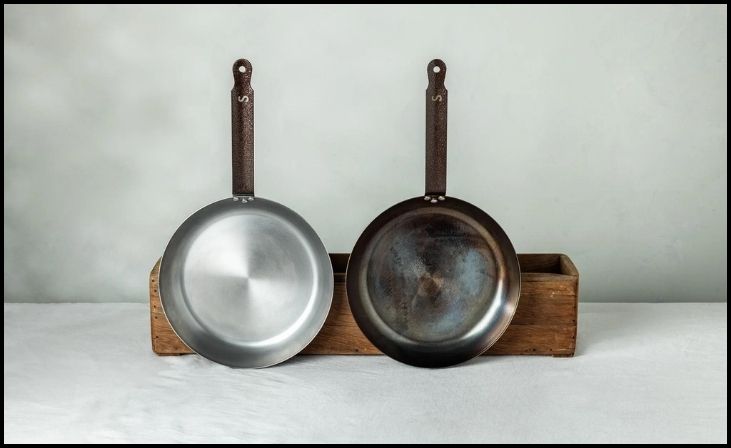
Carbon steel cookware is durable and heat-resistant like cast iron, nonstick, and fast-heating like stainless steel. Carbon steel cookware heats unevenly, rusts easily, and reacts to acidic food.
Carbon enhances hardness, strength, and brittleness but reduces malleability. In addition to skillets and woks, carbon steel cookware can be found in pots, roasters, and other pans.
It can be used for various recipes, ingredients, and cooking methods.
Although carbon steel cookware is more widespread in restaurants than in home kitchens, everyone can benefit from using it.
Pros
- retains heat well
- lightweight
- naturally nonstick
Cons
- requires seasoning
- cleaning isn’t the easy
- not dishwasher safe
Silicone
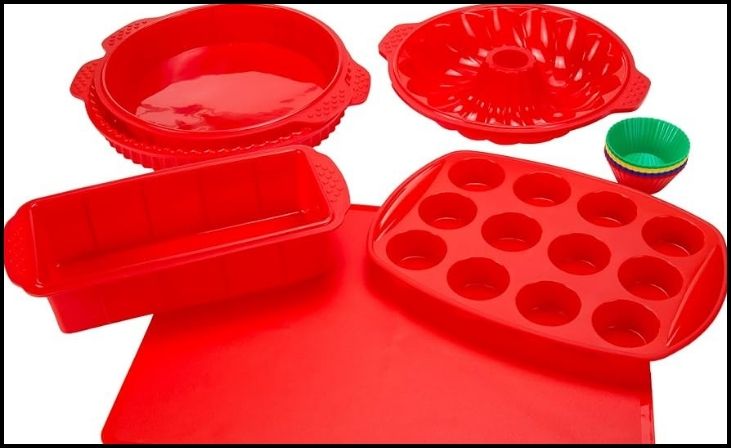
Silicone is the new nonstick cooking material. As well as being a nonstick material that may be used to prepare food, silicone can be used to bake, chill, freeze, and even serve it.
It’s been used primarily in bakeware, but silicon is the material of choice for the next generation of kitchen tools, including ladles and spoons. Flexible, dishwasher-safe, and even foldable, the silicone sheets and molds are a must-have.
Additionally, silicone mats may be used to roll out doughs without sticking, making them an indispensable tool for every baker, whether at home or in the industry. Silicon, on the other hand, is a poor heat conductor and a costly material.
Pros
- stain-resistant
- easy to clean
- nonstick
Cons
- poor heat conductor
Making A Final Decision
Each cookware material serves a different purpose. Thus there’s no best. The best material depends on your collection and cooking style.
Here are a few more tips when choosing a cookware set: Many cookware is dishwasher safe. However, hand washing will extend their life. If you want the greatest cookware, buy heavier pots and pans made of superior quality materials. Last, there is no best material. It depends on your cooking requirements.
You can also check the below video.
Frequently Asked Questions
In terms of heat retention, nothing beats cast iron cookware. These heavy-duty pans are ideal for deep-frying and searing steaks because of their ability to retain heat. When properly cleaned and maintained, cast iron can last for decades.
It’s possible to have all the benefits of cast iron without the rough surface by using carbon steel pans, which have a smoother surface and are lighter in weight. For those who prefer carbon-steel cookware, Lodge is a popular choice.
Not only is stainless steel a very high-quality and long-lasting metal, but it is also the material that presents the least amount of health risks when used in the home. It is because stainless steel doesn’t react with food.

Leave a Reply